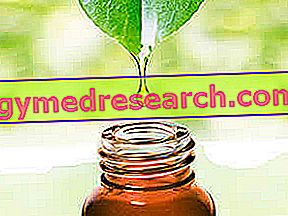
The SPF, sun protection factor, is an index of the level of protection of a solar product against UV rays and is expressed with a numerical value determined by physical and biological tests, which include tests in vivo or in vitro.
In vivo method
The tests are carried out on volunteers and the SPF is evaluated through the MED (minimal erythematous dose), expressed as the amount of energy required to cause a redness with clearly defined boundaries, which occurs from 16 to 24 hours after radiation exposure . The ratio between the MED on protected skin (the application of the filter must have a concentration of 2mg / cm2) and that on unprotected skin indicates the numerical value of the SPF:

For example, a sunscreen with SPF 2 indicates that a person can expose themselves to solar radiation twice as long, compared to the absence of protection, before the onset of skin erythema occurs; in fact it is a value compared to the MED characteristic of each individual.
In vitro method
The in vitro determination has the value of a screening and is a useful basic parameter for the subsequent determination of the in vivo MED.
The in vitro SPF determination principle was first theorized and applied by Brian L. Diffey and J. Robson in 1989. The method is based on the measurement of the spectral transmittance of a product, or the ratio between the transmitted radiation from the sample and the total incident radiation. By applying a known quantity of product on a suitable substrate with a predetermined surface, so as to obtain a homogeneous translucent film, the monochromatic spectral transmittance T (λ) is obtained:

where is it:
- Ss (λ) is the transmittance of the substrate at the wavelength λ;
- S0 (λ) is the transmittance of the substrate when the sample has been stratified on it.
By quantifying this value every 0.5 nm, in the total arc of the wavelengths (290-400 nm), the SPF value of the product is obtained, given by the equation:

- E (λ) is the spectral irradiance of sunlight, measured in summer at 12 o'clock in southern Europe, at 40 ° north latitude, 20 ° zenith angle, ozone layer thickness 0.305 cm;
- B (λ) is a spectrum of erythematous action of solar radiation, obtained from Mc Kinlay and Diffey by comparing over 12 erythematous action spectra measured between 1929 and 1985.
The analysis of the product according to this method allows to obtain three different values:
- UVA / UVB ratio;
- Sun protection factor (SPF);
- UVA protection factor.
Protection against UVA rays
The evaluation of protection against UVA rays represents, in the current state of knowledge, a real difficulty in its quantification; in fact, there is no biological parameter that is easily measurable and universally shared by the scientific community that can reflect all the effects of UVA on the skin. Currently, three in vivo methods for the evaluation and numerical quantification of photoprotection in UVA are indicated:
- IPD: Immediate Pigment Darkening;
- PPD: Persistent Pigment Darkening;
- UVA-PF: UVA Protection Factor.
IPD and PPD measure the biological parameter of immediate or permanent pigmentation. UVAPF measures the minimal erythematous response and especially the persistent staining. Although these test methods are considered and used as reference methods, in vitro test methods can also be considered, also considering that, in this case, there are no problems related to the ethical point of view.
Since September 2006, the European Commission has approved legislation that regulates the labeling of solar product packaging; not only the packages must have the SPF of the product, but a normalized UVA label must be introduced which indicates a minimum quantified protection against these rays, which increases in parallel with the sun protection factor and is based on a standardized test method (COLIPA Recomandation No. 21 Labeling of sunscreen products with UVA protection claim). The required level of UVA protection is a minimum 1: 3 ratio of UVA protection / UVB protection.
The characteristic protection degree of the solar product is thus evaluated according to the SPF value and through descriptive categories; it is necessary to use descriptions such as "low" protection; "average" ; "High" and "very high", along with traditional sun protection indicators, as shown in the table.
| Category shown on the label | SPF | Recommended minimum UVA protection factor |
| Low protection | 6 - 10 |  |
| Medium protection | 15 - 25 | |
| High protection | 30 - 50 | |
| Very high protection | 50 + |
Critical analysis and technical commentary on some commercially available solar products:
- Avène Sun Face Cream SPF20
- Fluid sun faces and body protection 20
- Nivea SUN Protect & Bronze FP20 s
- Crème solaire haute protection UVB 30
- Milk Protective Solar Spray 10
- DermaSol Baby Protective Solar Cream High protection 1-3 years
- Sun Sensitive - Anti-age Sun Milk SPF 15
- Piz Buin Active Fresh Cooling Spray SPF 30
- SOL - Waterproof Green Tea with the aroma of citrus fruits SPF 6
- Classic Sun milk Basic protection 10
- Baby sun - with Pluridefence and Sesame oil high protection SPF 30
- Coppertone - Tropical Blend Tanning Cream SPF 6
- Moisturizing Super Tanning Milk SPF 15
- Shiseido Tanning emulsion Lait bronzant SPF 6



